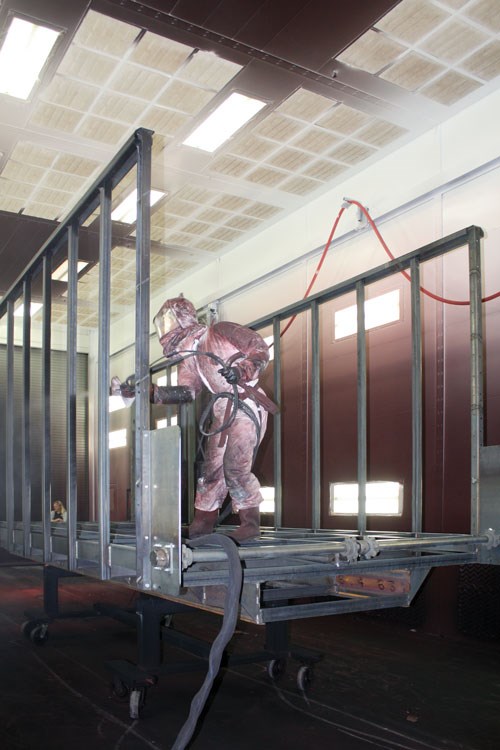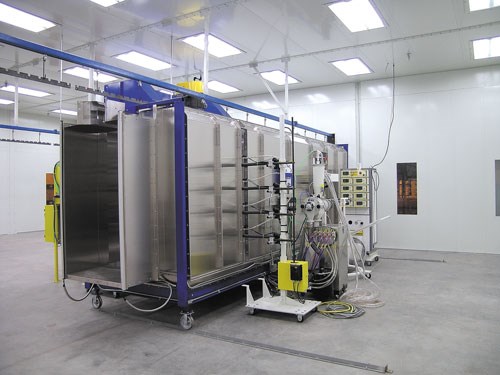The Most Important Part of the Finishing Process
Starting, stopping and the points in between, the author walks you through the most critical steps of the process.
In many instances, I have been asked by customers, “What is the most important step in the powder coating or painting process?”
Sometimes, it’s a humorously stealthy question, almost as if the customer looks both ways, lowers his voice and says, “You can tell me. I won’t tell anyone you told me.”
The most important part of the finishing process? This is like asking the most important part of your car—the engine or the brakes? Yes you want to go, and go fast, but at some point stopping becomes very important, too.
Starting, stopping and the points in between: they are all important in the finishing process. So before we discuss the equipment, do you know what you want to accomplish beyond coating your product? Do you have a hardness specification? A salt spray specification? The corrosion resistance you need? Have you studied the requirements of your industry, customer or specification? Have you studied the map?

Do you know what you want to accomplish other than just coating your product?
Research
Great places to go for information are the Chemical Coaters Association International, the Powder Coating Institute, the Society of Manufacturing Engineers, the annual Products Finishing Directory and Technology Guide and pfonline.com. All are great places to find reading materials on chemicals, coatings, surface preparation and equipment requirements.
Do not forget the codes you will need to meet: the International Building Code, the International Electric Code and the International Fire Code. The National Fire Protection Association has a good website where you can get educated about the standards on which the codes are based.
Now that we are through name dropping, let’s get on with the system.
First, do the math: number of products × the number of parts per product = items to be processed. Size of parts × space needed to hang or hold × number per day needed = line speed, or needed speed of processing. How do you rack or hold your part? Budget: What can you afford? This will all guide you quickly to the right equipment.
A general guideline is that if the required speed is less than 3 feet per minute, then go batch; if the requirement is greater than 3 feet per minute, then a powered conveyor should be used.

Don't forget the codes you will need to meet: the International Building Code, the International Electric Code and the International Fire Code
Steps and Equipment
Material Handling Method
How you move your products will determine the types of equipment listed below. Each has pros and cons, and, very importantly, a price tag.
Carts are typically for the initial system and batch operation. Pros: least expensive (although the casters can be pricey). Carts can hold lots of parts and different size parts. Cons: take up lots of floor space, track contaminants from process to process, can have tipping hazards, and can get heavy and difficult to roll.
Manual overhead conveyors can actually be in the same price range as carts. Again, this is for batch operation. Pros: versatile product racking/handling, take up less floor space than carts, track less contaminants through processes, and possibly facilitate a more dense/efficient loading of the oven. Can also be used in combination with carts in batch equipment. Cons: still require manual labor to move, can’t shove one rack aside to do a different rack.
Overhead conveyors are more expensive than A or B. Pros: provide for higher production rate with less labor to move part racks; much less cross contamination, different designs available to move carts, racks or power and free. Cons: weights and sizes will be limited to the original design of system.
Surface Prep
Don’t forget your chemical supplier. When it comes to aqueous cleaning, your chemical supplier defines the process needed to clean your products. These cleaning products and recommendations are what the equipment suppliers need to build you the correct equipment. The raw materials you use have contaminants and soils on them, and these need to be removed. As you process your products, cutting, bending, drilling and burning occur and you have changed and added more soils and contaminants. These have to be removed completely.
Multiple stage washers are used with powered conveyor systems, provide excellent cleaning and rinsing of parts, provide a conversion coating and have a repeatable, consistent product preparation without contamination from personnel handling. Limited rust and smut removal.
Manual wash booth and equipment can provide excellent cleaning at high pressures such as 1,000 psi, handle very large or heavy products, provide a conversion coating and can reach cavities. Limited production speed.
Grit blast is excellent for rust, rough surface contaminants and welding smut, and can be used in continuous production. Not for oil removal, and provides no conversion coating.
Know what your coating needs are for maximum adhesion and corrosion resistance. To this point, it is the most important part of your system.
Dry Off Oven
Dry your part, and dry it completely (bone dry). Considerations are temperature, time and air flow. Paint and powder—even water-based paints—are not to be applied to a wet part. Since this is about coating application, that is very important.
Booths, Paint or Powder
Chief considerations are what environment your coating supplier recommends for proper application. Important points: temperature, transfer efficiency, coating (mil) thickness, humidity, air flow velocity. Know what is needed and require this from your equipment supplier. If any of these specifications are not met, the chance of rejects increases.
The Application Equipment
Up until now, all of our discussion has been on the handling and preparation of the part. Now we come to the coating. Powder is typically a nonvolatile product, but needs to remain clean and dry. Solvent-based paints, however, are volatile and flammable and require proper storage and handling to meet codes.
Water-based paints have special handling requirements along the same lines as solvent-based paints. In bulk form, they are generally safer, but when sprayed, may be explosive, and the overspray may be considered combustible deposits. Don’t damage or contaminate your coating, and apply it efficiently.

A chief consideration is the environment a coating supplier reccommends for proper application.
The Curing Method
With ovens, of course, the No. 1 criteria is a complete cure. So this is a piece of equipment that warrants special consideration. Heating solvent- or water-based paints too quickly can cause solvent popping or bubbling. With powder coating, you can blow powder off of products, which can contaminate other products in the oven or require reprocessing. A good oven is an oven with temperature uniformity. If parts of the oven temperature range too high or low, you will not achieve the proper cure.
•Spray and cure spray booths are used with large parts, such as automobiles. When you are finished painting and ready for curing mode, it is no longer a spray booth, it is a Class A Oven. Make sure the supplier follows NFPA 86, provides explosion relief and an air make up rated for this process. (Caution: some say they do, but don’t. Make them prove it.) A good inspector will not let you operate it in the cure mode, and your insurance carrier will make sure. There are special clauses concerning a spray cure booth; read and know them.
•Convection ovens are heated air of the correct velocity applied uniformly, or to the correct area of the product. Look for uniformity and sufficient heat to complete the process.
•Infrared ovens cure by using wavelengths and are a very efficient form of heat transfer. So efficient, in fact, that they must be controlled correctly so as to not overheat the product and burn the coatings.
•A combination of infrared and convection oven can be very effective using the best of both technologies. An infrared zone at the beginning melts the powder and starts bringing the part up to temperature, then a convection oven finishes the cure.
Cool Down
Many systems just use time to allow a part to cool at its own pace. This is fine for some, but time is money. A mechanical cool down should be considered for cooling after a dry-off or cure oven so that parts are brought to the correct temperature in an appropriate amount of time and can be moved on to the next process.
The most important part of the system is you. Do the math, know your process and select chemical and coating suppliers that can prove their material. Then, pick equipment suppliers that don’t cut corners and who will design your systems and support equipment to meet the codes and process design requirements.
You have heard the saying, “You get what you pay for.” I say, “If you are lucky.” And what I really mean is, “If you do your homework.”
Do the right thing and be informed; that is the most important part of the process.
Originally published in the August 2015 issue.
Global Finishing Solutions
Related Content
Mix of Automation and Skilled Employees Generates Quality
This Pennsylvania plating company’s general manager shares insights about being recognized as a Top Shop for several consecutive years as well as his thoughts about automation, customer service, hiring skilled workers, the challenges of installing a new line and more.
Read MoreConveyors and Paint Systems
Choosing the right conveyor system, coating technology, and ancillary equipment.
Read MoreTTX’s Automated Conveyor Carrier System Offers Wireless, Flexible Operation
ACC system designed for reliable, consistent point-to-point movement of everything from small to heavy parts.
Read MoreMasking Solutions Provider CFS Dramatically Expands Capabilities and Capacity
Custom Fabrication & Supplies (CFS) completed a new plant expansion packing 10 times the capacity into twice the space. It dramatically enhances the supplier’s custom capabilities to provide extremely precise and cost-effective masking solutions.
Read MoreRead Next
Education Bringing Cleaning to Machining
Debuting new speakers and cleaning technology content during this half-day workshop co-located with IMTS 2024.
Read MoreEpisode 45: An Interview with Chandler Mancuso, MacDermid Envio Solutions
Chandler Mancuso, technical director with MacDermid Envio discusses updating your wastewater treatment system and implementing materials recycling solutions to increase efficiencies, control costs and reduce environmental impact.
Read MoreA ‘Clean’ Agenda Offers Unique Presentations in Chicago
The 2024 Parts Cleaning Conference, co-located with the International Manufacturing Technology Show, includes presentations by several speakers who are new to the conference and topics that have not been covered in past editions of this event.
Read More










.jpg;maxWidth=300;quality=90)










